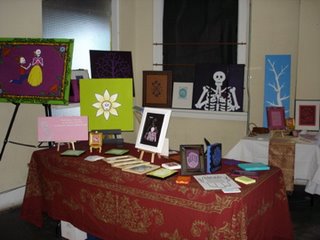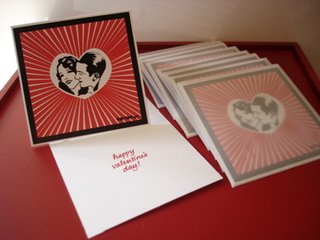a beginner's guide to showing your artworki'm certainly no pro, but it seems like every time i've shown work lately i've been approached by other artists who are curious as to how i got my work at the venue. i had one particularly lengthy conversation on friday and thought it might help others if i shared my experience.
first and foremost, i am NOT a trained artist. i did NOT go to art school and i do NOT pursue art as a full-time career, nor do i particularly want to. i have a day job that often bleeds into my nights and weekends, and consequently the advice i'm about to dispense may not jive with what "real" artists are taught in school. so this is for the folks that do i what i do: paint and create on their own time to keep their sanity, and after a certain amount of time and comments from friends and family, decide to share what they have with the public.
1. decide how seriously you want to take this. do you want to sell your work or just share it? are you interested in people commissioning you to do artwork for them? some of this decision-making will have to come with time, as you figure out what "market" best fits you and how much time you're able to devote to selling your work. find a way to spread the word easily; there are TONS of options these days... websites, business cards, listings, craigslist, myspace, newspapers, zines, etc. i personally stay away from promoting my art on the web aside from my personal website, but there are tons of websites that serve simply to expose other people to your art. myspace may be a good option but remember, it's a fad and will likely fade out in a couple years. finding something with a bit more permanance might be better in the long run.
2. now it's time to get out there. coffee shops are some of the easiest places to approach; if they've got art on the walls, ask what the process is for getting yours up there. some places have a person in charge that you have to email, other places just want you to show samples to a manager. ask if there is a commission taken and how sales are handled (some places will accept sales and save the money for you, others prefer not to handle anything and want you to have your own way for customers to contact you). festivals and fairs are a bit more tricky. you often have to deal with an application process and setup at the venue. it is VERY important to know if the event is outdoors; weather can hugely affect presentation and many outdoor places require tents. most festivals/fairs take either a commission or charge a booth fee. make sure it's worth your while to pay these charges; selling $2 magnets may not result in a profit if your booth fee is $75. craigslist is also a really good resource, but don't be surprised when venues AND other artists are flaky with their responses. follow up with emails and phone calls... many artists are talented but lazy, and my persistence has often landed me a show when someone else flaked out. getting into galleries and art houses is a very laborious process... they usually require an application, work samples (sometimes slides), curriculum vitae and/or artist's statement. lots of good resources to help you compile these on the web, but don't be phased by rejection. a lot of getting into such things is about who you know.
3. NETWORK... sadly, in certain art scenes it's much more about who you know than the quality or consistency of your art (although yes, that's very subjective!) be careful not to make empty promises about donations or free work unless you plan on following through and/or have the work on hand to back it up. some intensely cheesy artists get their stuff up simply because they know how to schmooze. if this is your thing, do it.
4. so now you've got a show... figure out your display! if you're putting up work, consider things like customer point-of-entry/exit, what pieces will be at eye level, hanging/display issues, and the other work that surrounds yours. i recently showed work where another artist did calaveras as well... make sure you display eye-catching pieces that demonstrate your best work and how it differs from others. once you've hooked someone's eye, they'll want to see more. some essentials to take with you: hammer, nails, pushpins, picture hangers, cards for listing title, medium, dimensions and YOUR NAME, scotch tape, packing/masking tape, string, pencil, sharpie. pack your work carefully to avoid scratches and mishandling and hang it high enough to avoid contact with customers (SUPER important at coffee shops/restaurants).
5. don't give up... rejection is part of the game. set realistic goals and stay true to yourself. if you think hanging work at chain coffee shops is selling out, don't do it. if you think selling work at a craft fair is cheesy, don't sell it. but the pickier you are about the places/events you're willing to show at, the more difficult it may be for you to get the recognition you want.
6. a final note about pricing. for me, i'm more interested in regular folks being able to buy my work than listing my pieces at ludicrous amounts... i'm an avid art buyer, so it makes sense. i like to at least break even or ideally make a slight profit. this is a wholely personal process. some people figure out prices based on labor and materials, even calculating formulas by the square inch. since some of my pieces i work on simultaneously and others can take a year to complete just because i rarely go back to them, this system doesn't work for me. it's mostly about media (prints are cheaper than paintings, big paintings with greater detail are more expensive than simple small paintings) and sentimentality (very personal pieces cost more). some people double prices when their work is framed, but i simply take into account the cost of the frame and raise the price slightly as to ensure i'm making money rather than losing it.
i hope this helps a few folks... if you've got any questions, leave a comment!



